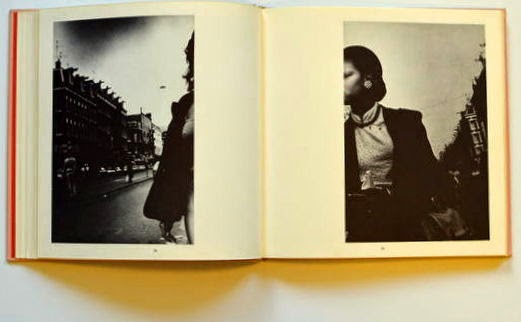FURUYA, SEIICHI. & HONNEF, KLAUS. - AMS.
Graz, Camera Austria, 1981. First edition of 600 copies. 24,5 x 24,5 cm. Hardcover (clothbound). Text in German and English. 89 pages.
On the last day of April, 1980, FURUYA Seiichi traveled to Amsterdam by car, (he was accompanying MORIYAMA Daido who visited Graz for three weeks to hold a solo exhibition at the Forum Stadtpark, Graz), and was so captivated by the energy of the city that from June he spent three months there photographing, supporting himself with a job as a waiter in a Japanese restaurant. He spent his spare time and weekends photographing, returning to his tiny room in the attic over the restaurant to develop the film. Christine visited FURUYA there for a short period and ten months later, their son, Komyo, was born. The expensive Japanese restaurant, ‘Toga’, where he worked, went out of business at the same time he left. Immediately upon his return to Graz, he began work on this, his first photo book*.
Furuya searches for the face of Amsterdam in the faces of the people crowding its streets. Accordingly, his perspective is that of the flâneur who calmly and casually, as it were observes the people hurrying past him. He does mix with the crowd, it is true, but, in marked contrast to the people rushing by or towards him, he is without plan or direction, as it seems. He simply drifts along. The city reveals itself to him in its busy crowds – crowds that present themselves in ever changing forms and constellations. He enjoys being engulfed by the crowd – something politicians are often to be heard enthusing about. Furuya's photographs speak of his fascination, but fascination is not all there is to them; even though this might be our impression at first glance.
The colorful figures – colorful in every way – that people Furuya's photographs greatly contribute to this impression. Hardly ever do we find a face that would be considered average. A motley of races appears in the photographs, expressive faces, though strangely rigid, even mask-like; not concentrated on the camera and the photographer, but on something outside the rectangle of the photograph, something not captured by it; fantastic figures in crazy get-ups, with the craziness and strangeness certainly not manifested solely by the extraordinary but rather, for the most part, by the very ordinariness of their dress, which sometimes strangely contrasts with the person it is supposed to clothe.
The colorful figures – colorful in every way – that people Furuya's photographs greatly contribute to this impression. Hardly ever do we find a face that would be considered average. A motley of races appears in the photographs, expressive faces, though strangely rigid, even mask-like; not concentrated on the camera and the photographer, but on something outside the rectangle of the photograph, something not captured by it; fantastic figures in crazy get-ups, with the craziness and strangeness certainly not manifested solely by the extraordinary but rather, for the most part, by the very ordinariness of their dress, which sometimes strangely contrasts with the person it is supposed to clothe.
…
Seiichi Furuya was born in Izu, Japan, in 1950. After graduating from Tokyo Polytechnic University in 1973, he left the port of Yokohama to travel to Europe on the Trans-Siberian Railway. He lived in Vienna until he moved to Graz in 1975. There he met Christine Gössler (born 1953) in February 1978. The couple married in May of the same year. Their son, Komyo Klaus, was born in 1981. In 1982, they moved to Vienna so that Christine could study drama. In 1984, Seiichi took a job as an interpreter and the family moved to Dresden, East Germany; and then in 1985, to East Berlin.
In late 1982, Christine began to exhibit symptoms of schizophrenia. In 1983, she entered a hospital in Graz for treatment; she was forced to give up her drama studies, and from that time on was in and out of hospital regularly. Shortly after noon on October 7th, 1985, the 36th anniversary of the founding of the German Democratic Republic, Christine threw herself from a window on the 9th floor of the tenement building where the family lived. Seiichi continued to work as an interpreter in East Berlin until 1987. Afterwards he returned to Graz, where he has lived with his son, Komyo, to this day.
Since 1975, FURUYA has had numerous exhibitions, both in Japan and overseas, at such venues as: Forum Stadtpark (Graz, Austria), Winterthur Museum (Switzerland), Albertina Museum (Vienna, Austria), the Vangi Sculpture Garden Museum (Mishima, Japan). He has published several photo books featuring Christine, starting with his Mémoires 1978-1988 (Camera Austria, 1989) and continuing with Mémoires 1995 (Scalo Books, 1995), Christine Furuya-Gössler, Mémoires 1978-1985(Korinsha Press, 1997), Portrait (Fotohof, 2000), Last Trip to Venice (self-published, 2002) Mémoires 1983 (Akaaka Art Publishing, 2006).
What’s more, he has been active in a wide range of projects: he was one of the founders and editors of the photography magazine, Camera Austria, and has also curated exhibitions introducing Japanese photographers to Europe, such as Daido Moriyama, (Graz, 1980), Shomei Tomatsu: Japan 1952-1981 (Graz, 1984), Nobuyoshi Araki Akt-Tokyo, 1971-1991 (Graz, 1992), Keep in Touch. Positions in Japanese Photography (Graz, 2003).




























Geen opmerkingen:
Een reactie posten